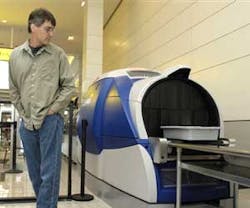3-D Scanner Testing Underway at BWI
Oct. 25--Passengers breezed through the security checkpoint. No fumbling to pull laptops out of carry-ons. No dumping those quart baggies of liquids and gels into plastic bins.
Shoes still had to come off, but otherwise it was just a matter of putting packed bags through a futuristic MRI-like scanner and going on their way.
Dozens of randomly selected Southwest Airlines passengers were sent yesterday through a checkpoint at Baltimore-Washington International Thurgood Marshall Airport that had a new automatic explosives-detection system being tested by the federal Transportation Security Administration.
The new imaging technology is the most recent in a series of experimental devices rolled out in the six years since the Sept. 11 attacks. Several devices have gotten early live tests at BWI, partly because of its proximity to Washington.
TSA officials say the Auto-EDS system, which is also being tested at airports in Cleveland and Manchester, N.H., could eventually replace the current X-ray technology at all airport security checkpoints.
But it's being introduced at a time when the TSA is coming under increasing criticism for being unable -- by either man or machine -- to guard against potential threats.
According to a classified government report that leaked last week, screeners at two of the country's busiest airports failed to detect simulated explosive materials hidden in the carry-on bags or clothing of undercover agents.
And in testimony before Congress last week, Cathleen A. Berrick of the Government Accountability Office said that the "TSA has not yet deployed checkpoint technologies to address key existing vulnerabilities."
The TSA is spending more than $13 million on Auto-EDS. Analogic Corp. received a $7.6 million contract for the 12 explosives-detection scanners that TSA initially purchased, while Reveal Imaging Technologies got $5.6 million for eight similar systems, first being tested in Manchester. Both companies are based in Massachusetts.
Analogic's system will roll out at the Dallas/Fort Worth International Airport in November and then in Miami, said Frank G. Vorwald, vice president of the company's security systems division.
Each machine, which is longer than a standard scanner but still fits into a checkpoint lane, sells for about $350,000, Vorwald said.
Analogic's devices use computed axial tomography (CAT), similar to medical scanners, which Analogic also produces. The device displays objects in three dimensions, compared to the two-dimension technology of X-ray scanners. The technology is supposed to enhance safety and also move people through security quickly by eliminating the scramble to remove sensitive items before putting bags on conveyor belts.
The scanner revolves around the objects on the belt, producing hundreds of images from all angles that are then reconstructed on a computer screen, Vorwald said. "It just makes it easier for the passengers," he said.
Any scanned potential explosive or weapon shows up with a red box around it on the computer screen, Vorwald said. The corresponding sections of such "hot" bags are then searched.
The Analogic system also includes a lower conveyor belt to ship the plastic checkpoint bins back to the passengers waiting to move through the scanner.
But the technology has its limitations: It still can't detect an explosive liquid, Vorwald said.
The Auto-EDS pilot comes more than two years after an explosives-detection "puffer" debuted at BWI with much fanfare. Though those screening devices were expected to change the face of airport security, only one remains in use at BWI, for secondary screening of passengers in a terminal that serves Continental Airlines, TSA spokeswoman Amy Kudwa said.
About 95 puffers, which use quick blasts of air to test for traces of explosive substances, are in use at the nation's airports, Kudwa said.
"We've got a lot of different technologies piloting," she said. "Any one layer alone can be gamed in some way."
Using a combination of pre-9/11 and newer equipment, the TSA now screens all checked luggage for metal and explosives that give off vapors or smells. But other screening devices have been introduced only selectively because of their cost and technological glitches; the puffers, for example, can become contaminated by particles and dust.
And the TSA has yet to showcase technology to detect liquid explosives, which are enclosed in containers that give off no vapors or smells and often are made up of substances that by themselves are harmless.
It wasn't clear from yesterday's test -- conducted at midday on a Wednesday in October -- how well the Auto-EDS system would work at peak flight times. Passengers moved through the checkpoint in about the same amount of time as at nearby checkpoints with X-ray machines, though they might have gone through faster if the flow hadn't been hampered by clustered reporters and TV cameras. Analogic says the system can process 400 bins or bags per hour with a conveyor speed of 20 feet per minute.
"It wasn't a full-tilt operation today," Kudwa said.
Not having flown since the Sept. 11 attacks, Towson resident Vira Froehlinger had heard horror stories from her children about long security lines and delayed planes. So the child psychologist was pleasantly surprised to move swiftly through the checkpoint en route to Orlando, Fla., for a conference yesterday.
Froehlinger, 79, would have kept her toiletries in her carry-on if she had known her bag would go through the new scanner.
"I expected a nightmare, but it's moving so quickly," she said. "It's fantastic."
Copyright (c) 2007, The Baltimore Sun Distributed by McClatchy-Tribune Information Services.

